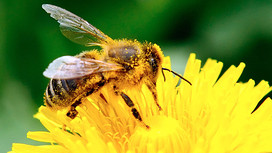By Dave Goulson
November 8, 2013
We could not have tried harder to wipe out the invaluable pollinator, writes Dave Goulson @Reuters
Biologists have been predicting for years that we might be facing a pollination crisis, where there are not enough bees and other
flower-visiting insects to go around. If this happens, yields of crops requiring insect pollination will drop, and food prices will rise.
About three-quarters of all crops depend to some extent on pollinators, including most fruit and vegetables – many of them
high-value foods that we all love, such as strawberries, coffee, blueberries, tomatoes, chillies and cocoa.
The lovable honeybee has become the face of this disaster scenario. But in truth, pollination depends on thousands of wild insect types,
such as bumblebees, flies and beetles.
Until recently, the crisis remained a theoretical possibility. But the recent rise in almond prices is one of several worrying signs that it
may be becoming a reality, at least in some parts of the world. About 1.5m honeybee hives are needed to pollinate the almond crop in
California, whose production dominates the world market. Many beekeepers are losing nests faster than they can replace them, and so
they are charging ever higher prices for their hives; the cost to almond growers of hiring a hive has tripled in recent years to about
$160.
Elsewhere in the world, the apple and pear farmers of Szechuan now use paint brushes to place pollen on each flower, sending their children climbing up to the higher branches. They are forced to do this because highly intensive farming with heavy pesticide use has all but eradicated bees. Anecdotal stories emerging from Brazil suggest passion fruit is now often hand-pollinated for the same reason. But
bees are far more cost-effective than people; if the day should arrive when California’s almond growers have to start hand-pollinating, few
of us will be able to afford a pack of nuts.
As a specialist in studying wild bees and their conservation, I am embarrassed to admit that we do not know how many pollinators we have, nor how their abundance has changed over time. Nobody does. There is no monitoring of numbers. We also do not know how many we need to ensure good crop yields and healthy wildflower communities.
So what exactly do we know? We have good maps of the distribution of wild pollinators for some countries, including the UK, and we know some species have disappeared from much of their former range. Some, such as the short-haired bumblebee, are extinct in the UK. We also know that the number of honeybee hives has greatly dropped in many countries; and that apiarists in many countries, notably in North America, are finding it increasingly difficult to keep their hives alive.
What is happening to our bees? The answer is complicated – but imagine the following. A flu epidemic sweeps the country, and you catch it. You feel awful but you struggle on, going to the shops to get food. The shop has closed down, and you have to walk an extra two miles to find an open shop. Exhausted and shivering, you buy some food and manage to eat some but it has been poisoned. Not enough poison to kill you if you were feeling well, but in this state?
It sounds a bit melodramatic, but it is a pretty good analogy for our poor bees. We have accidentally spread new parasites and diseases of
bees around the world; for example, many bumblebees in the UK are infected with a gut parasite originally from Asian honeybees, while
honeybees are being ravaged by the Asian Varroa mite. Modern farming has removed most flowers from the countryside, so pollinators have to travel further to find nourishment – and the range of foods available is restricted. Much is contaminated with a cocktail of pesticides; recent studies found up to 35 different pesticides in the food stores of honeybees. Small wonder, then, that pollinators are not thriving.
Global food production has been heading in an unsustainable direction for decades. The UN’s Food and Agriculture Organisation estimates that we will need to double global food production by 2050 to feed the growing population. We continue to clear tropical forests to bring more land in to use, and we try to squeeze ever greater yields from existing land by heavy use of fertilisers and pesticides, creating vast crop monocultures. Yet our efforts are undermining the ability of land to produce food. Agricultural practices are causing soils to be rapidly eroded – washing away in rain or blowing away into the sea – so that 40 per cent of farmed soils are already degraded, and some estimates suggest many countries will have little soil left within 60 years. Aquifers used to irrigate arid soils are fast being depleted. Salt build-up, from poor irrigation practices, is affecting 320m hectares of agricultural lands – an area the size of India.
Extreme climate events expected as a result of build-up of greenhouse gas emissions are likely to cause catastrophic crop failures. Wild
fish stocks are being depleted; many have already collapsed. Species are going extinct at about 1,000 times the natural rate, many of which have vital roles in recycling nutrients, storing carbon, creating soil, controlling pests and, of course, pollinating crops. Bees may be
canaries in the coal mine, warning us that we must find ways to produce food without destroying the environment on which we depend.
The writer is professor of biology at Sussex university and author of ‘A Sting in the Tale’

